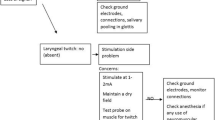Abstract
Purpose of Review
To explore how the different types of intraoperative neuromonitoring (IONM)—namely intermittent (I-IONM) and continuous (C-IONM)—differ from each other and to examine how these differences can affect expected outcomes from IONM.
Recent Findings
Intraoperative neuromonitoring (IONM) is an important surgical tool for assessment of nerve functional status during surgical procedures where a particular nerve is at risk of injury. IONM has evolved especially in the thyroid/parathyroid surgical space. Accurate use of IONM is dependent on correct set-up of the monitoring equipment and on the surgeon’s implementation and responsiveness to the information provided by the equipment. I-IONM and C-IONM are complementary and together facilitate an unparalleled window into intraoperative neural functional integrity. Rate of nerve palsy is not the only outcome to consider when designing a study to define the utility of IONM in surgery. Other outcomes that are important to consider include alterations in surgical decision making based on IONM data including staged surgical approaches and enhanced localization abilities (especially important for I-IONM techniques); temporal course of a nerve injury (especially important for C-IONM); and changes in surgical technique over time induced by intraoperative nerve functional feedback (especially important for C-IONM).
Summary
The surgical team should be realistic about what they wish to achieve with IONM and choose the form IONM to be used based on these requirements.

Similar content being viewed by others
References
Papers of particular interest, published recently, have been highlighted as: • Of importance •• Of major importance
•• Schneider R, Randolph GW, Dionigi G, et al. International neural monitoring study group guideline 2018 part I: staging bilateral thyroid surgery with monitoring loss of signal. Laryngoscope. 2018;128(Suppl 3):S1–s17. Excellent summary of paradigms for staging thyroid surgery using IONM.
Wu CW, Dionigi G, Barczynski M, et al. International neuromonitoring study group guidelines 2018: Part II: optimal recurrent laryngeal nerve management for invasive thyroid cancer-incorporation of surgical, laryngeal, and neural electrophysiologic data. Laryngoscope. 2018;128(Suppl 3):S18–s27. Excellent summary of use of IONM in preservation or sacrifice of invaded nerves.
Tomoda C, Hirokawa Y, Uruno T, Takamura Y, Ito Y, Miya A, et al. Sensitivity and specificity of intraoperative recurrent laryngeal nerve stimulation test for predicting vocal cord palsy after thyroid surgery. World J Surg. 2006;30:1230–3.
Wu CW, Wang MH, Chen CC, et al. Loss of signal in recurrent nerve neuromonitoring: causes and management. Gland surgery. 2015;4:19–26.
• Sinclair CF, Tellez MJ, Ulkatan S. Continuous laryngeal adductor reflex versus intermittent nerve monitoring in neck endocrine surgery. Laryngoscope. 2020;131:230–6. https://doi.org/10.1002/lary.28710. Trial comparing I-IONM to C-IONM.
• Schneider R, Machens A, Sekulla K, et al. Superiority of continuous over intermittent intraoperative nerve monitoring in preventing vocal cord palsy. Br J Surg. 2021;108(5):566–73. Trial comparing I-IONM to C-IONM.
• Sedlmeier A, Steinmüller T, Hermanns M, Nawka T, Weikert S, Sedlmaier B, et al. Continuous versus intermittent intraoperative neuromonitoring in complex benign thyroid surgery: a retrospective analysis and prospective follow-up. Clin Otolaryngol. 2019;44:1071–9. Comparative analysis of C-IONM and I-IONM.
• Schneider R, Sekulla A, Machens K, Lorenz P, Nguhen T, Dralle H. Postoperative vocal fold palsy in patients undergoing thyroid surgery with continuous or intermittent nerve monitoring. Br J Surg. 2015;102(11):1380–7. Comparison of I-IONM and C-IONM.
Jeannon J-P, Orabi AA, Bruch GA, Abdalsalam HA, Simo R. Diagnosis of recurrent laryngeal nerve palsy after thyroidectomy: a systematic review. Int J Clin Pract. 2009;63(4):624–9.
Snyder SK, Lairmore TC, Hendricks JC, Roberts JW. Elucidating mechanisms of recurrent laryngeal nerve injury during thyroidectomy and parathyroidectomy. J Am Coll Surg. 2008;206:123–30.
• Phelan E, Schneider R, Lorenz K, Dralle H, Kamani D, Potenza A, et al. Continuous vagal IONM prevents recurrent laryngeal nerve paralysis by revealing initial EMG changes of impending neuropraxic injury: a prospective, multicenter study. Laryngoscope. 2014;124:1498–505. Early study of C-IONM benefits.
Ulkatan S, Waner M, Arranz-Arranz B, Weiss I, TMJ O, Saral M, et al. New methodology for facial nerve monitoring in extracranial surgeries of vascular malformations. Clin Neurophysiol. 2014;125(4):849–55.
Brauckhoff K, Vik R, Sandvik L, Heimdal JH, Aas T, Biermann M, et al. Impact of EMG changes in continuous vagal nerve monitoring in high-risk endocrine neck surgery. World J Surg. 2016;40:672–780.
Author information
Authors and Affiliations
Contributions
All authors contributed to the study conception and design. Material preparation, data collection, and analysis were performed by CF Sinclair and GW Randolph. The first draft of the manuscript was written by CF Sinclair, and all authors commented on previous versions of the manuscript. All authors read and approved the final manuscript.
Corresponding author
Ethics declarations
Conflict of Interest
Dr Catherine F Sinclair is named as an inventor on a patent held by Mount Sinai Innovation Partners, filed on 12/23/2016, entitled “Improved Method and System for Assessing Laryngeal and Vagus Nerve Integrity in Patients Under General Anesthesia.” Dr Gregory W Randolph has no competing interests.
Human and Animal Rights and Informed Consent
This article does not contain any studies with human or animal subjects performed by the author.
Consent for publication
CF Sinclair and GW Randolph hereby consent for publication of the content of this article by Current Otorhinolaryngology Reports.
Additional information
Publisher’s Note
Springer Nature remains neutral with regard to jurisdictional claims in published maps and institutional affiliations.
This article is part of the Topical collection on Nerve Monitoring in Head and Neck Surgery
Rights and permissions
About this article
Cite this article
Sinclair, C.F., Randolph, G.W. A Thoughtful Approach to IONM Outcomes Reporting. Curr Otorhinolaryngol Rep 9, 341–344 (2021). https://doi.org/10.1007/s40136-021-00364-4
Accepted:
Published:
Issue Date:
DOI: https://doi.org/10.1007/s40136-021-00364-4




